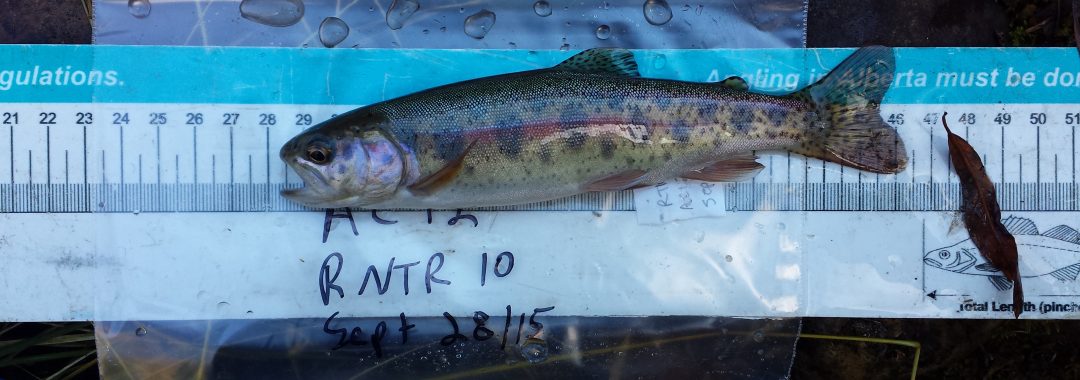Thesis Title: Assessing the impacts of multiple ecological stressors on an endangered native salmonid, the Athabasca Rainbow Trout, in the foothills of the Canadian Rocky Mountains.
Author: Nathan Medinski
Abstract
Freshwater fish face a multitude of ecological stressors, which has resulted in substantial declines in aquatic biodiversity. The loss of aquatic biodiversity can lead to changes in ecosystem function, productivity and food web dynamics. One such imperiled freshwater fish is the Athabasca Rainbow Trout (Oncorhynchus mykiss), a unique Rainbow Trout ecotype found in the upper reaches of the Athabasca River watershed, forming the only native Rainbow Trout population in Alberta. Athabasca Rainbow Trout have experienced widespread declines in abundance, with losses of approximately 90% over the last three generation, or approximately 15 years. Two of the main ecological stressors impacting Athabasca Rainbow Trout are competition with invasive Brook Trout (Salvelinus fontinalis) and habitat degradation associated with natural resource extraction developments in the region. For example, in 2013 the accidental breach of a tailings dam at the Obed coal mine near Hinton, Alberta, Canada, released 670,000 m3 of coal tailings material into Athabasca Rainbow Trout habitat. My goal in this thesis was to improve our understanding of ongoing impacts from multiple ecological stressors on Athabasca Rainbow Trout abundance and food resource use, inferred from sampling seven streams in the upper Athabasca River watershed. The specific objectives of this thesis were therefore to: 1) determine how this ecological stressor gradient has influenced Athabasca Rainbow Trout abundance in the foothills of west-central Alberta, and 2) understand how food resource utilization by Athabasca Rainbow Trout populations has been affected along a disturbance gradient associated with habitat degradation from the Obed mine tailings release and competition with invasive Brook Trout.
To meet my first study objective, I compared Rainbow Trout abundance with metrics associated with mining impacts to aquatic systems, landscape level stressors, abundance of invasive species and general stream habitat parameters between waterbodies along a gradient of ecological stressors. I determined that Athabasca Rainbow Trout abundance was not significantly different between groupings of streams impacted by the Obed mine tailings release compared with reference streams but was lowest in streams that were both highly turbid and had high abundance of invasive Brook Trout. To answer my second study objective, I used stable isotope analysis to determine trophic position, carbon source pathways, diet composition, niche width and resource use overlap to infer if food resource use changed along a disturbance gradient. I found that Athabasca Rainbow Trout in tailings disturbed waterbodies were utilizing a wider breadth of dietary resources and had substantially higher niche overlap with Brook Trout than in waterbodies not impacted by the tailings release, indicative of greater competition for food resources.
This thesis contributes to our understanding of how endangered Athabasca Rainbow Trout populations have been impacted by multiple ecological stressors and quantifies important interactions between these stressors with fish abundance and food resource use. Fisheries managers may wish to pursue additional measures to prevent subsequent declines in Athabasca Rainbow Trout populations by minimizing the detrimental impacts associated with landscape level habitat degradation and competition with invasive Brook Trout.

